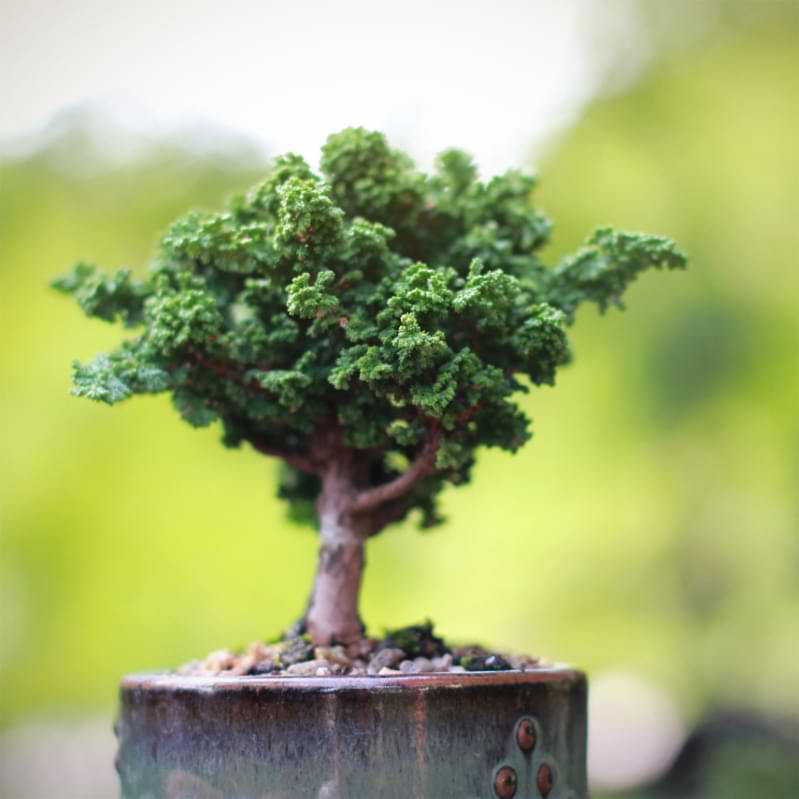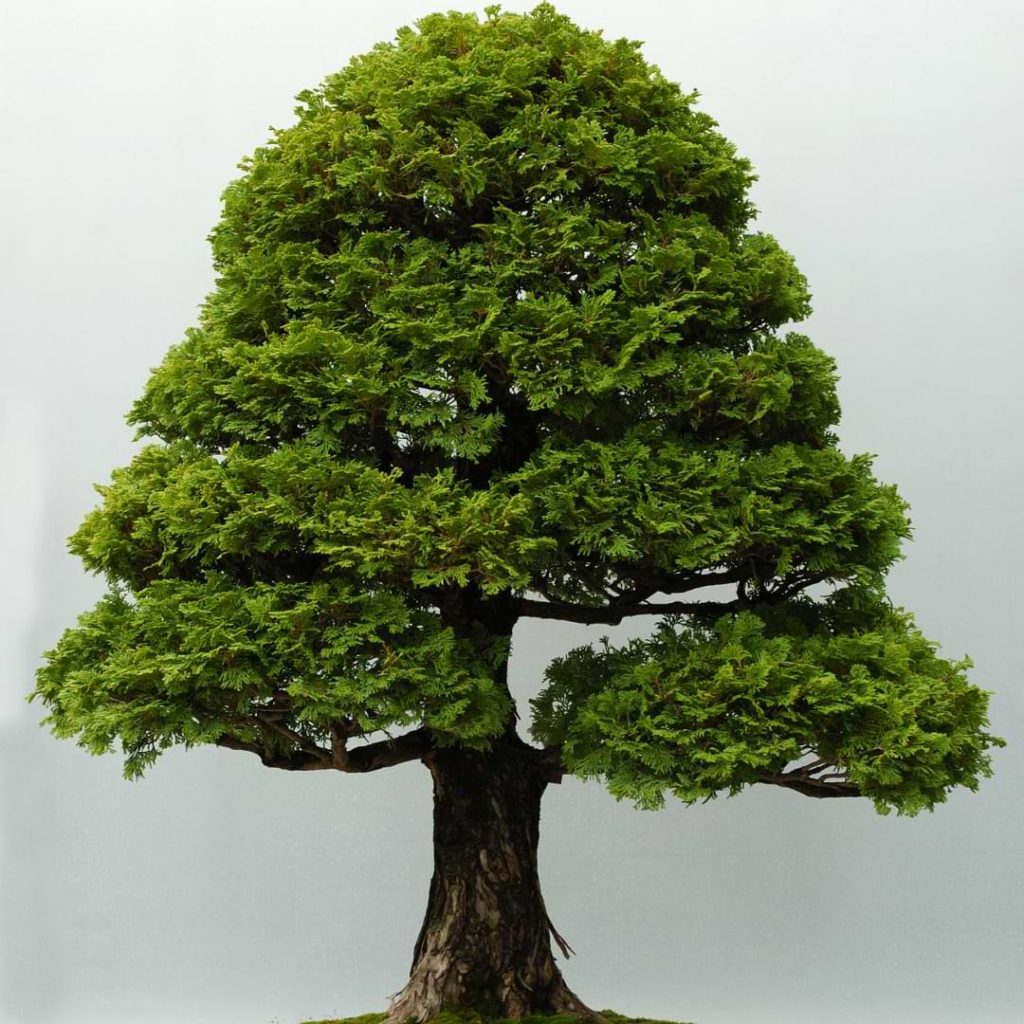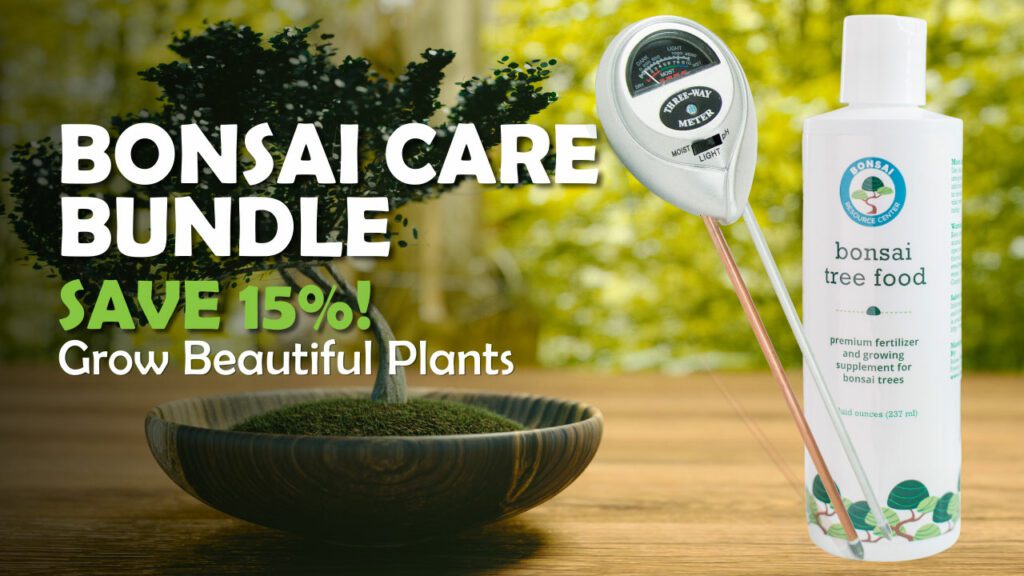Looking for a stunning bonsai plant that only grows more attractive as it ages? Hinoki cypress bonsai might be exactly what you’re looking for!
Hinoki cypress has dark-green leaves that form fanlike layers and grow on branches that resemble ferns, and its trunk has peeling red-brown bark.
Despite the name, the hinoki cypress is a false cypress rather than a true cypress. This plant belongs to the Chamaecyparis family while true cypresses belong to the Cupressus family. False cypress still resembles cypress even though they fall within a different family. The naming is confusing, but don’t spend too much time worrying about the label.
In its native environment in Japan, the hinoki cypress can grow up to 130 feet tall. However, there are several dwarf varieties, and these are generally the ones used for bonsai.
Unfortunately, the hinoki cypress is not the easiest tree to care for as a bonsai. Don’t let that deter you, though. The main issue with hinoki cypress is that it grows quickly and requires extra maintenance to keep pruned. The plant itself is relatively hardy while in a container, so you are unlikely to kill it. The bonsai might just not look exactly the way you envisioned if it gets out of hand.
While hinoki cypress is not an ideal choice for someone new to bonsai, it is possible to provide the care that hinoki cypress needs to thrive. You just have to be willing to put in the extra effort.
If you carefully attend to a hinoki cypress’s specific needs, then you’ll have a beautiful bonsai specimen.
Position
Hinoki cypress is an outdoor bonsai and should not be placed indoors. The plant needs full sunlight during both the growing season and during the winter if possible.
Keep your hinoki cypress bonsai in a protected area away from frost and wind during the winter months.
Humidity and Temperature
Hinoki cypress is hardy, but your bonsai should be protected when temperatures fall below 20 degrees Fahrenheit. High winds paired with low temperatures can quickly dry out this plant during the winter months.
When the weather turns bad during the winter, store your hinoki cypress in an unheated area. This will protect it from extreme temperatures. The plant still needs lots of access to light, and you should avoid placing it near a heater because this will cause the plant to lose too much moisture.
While it is important to keep your cypress bonsai out of the extreme cold, it is equally important to provide light. Without enough light, the branches will begin to die.
Soil
Hinoki cypress bonsai need quick-draining soil that is lime-free and slightly acidic. If you live in a hot climate, you will need to add in material to help the soil retain a little extra water.
Correct soil is particularly important because hinoki cypress are picky about the level of moisture their soil retains. They require large amounts of water, but root rot can occur quickly if too much water remains in the soil.
How Often Do You Water Hinoki Cypress Bonsai?
To keep your bonsai in optimal condition, water regularly during the growing season from spring until fall. The soil should dry out slightly between waterings, but watering should occur frequently. While hinoki cypress is growing, it requires a lot of water; however, its roots can quickly become waterlogged if excess moisture is allowed to remain in the soil for too long. This is why it is so important that hinoki cypress bonsai be planted in fast-draining soil.
Expect to water about once a day during the summer depending on your climate. Plan to water less frequently during the winter, but do not allow the root ball to dry out completely between watering.
You can mist the leaves to add additional humidity if your climate is dry. Just be sure to do this in the morning so that water droplets left on the needles do not act like a magnifying glass in bright sunlight and damage the plant.
When to Fertilize Hinoki Cypress Bonsai?
Because bonsai are grown in containers, they do not have access to the same range of nutrients that they would be able to access if they were grown in the ground. For this reason, fertilizing is recommended to keep your bonsai in the best condition.
When selecting a fertilizer, choose a balanced fertilizer (a balanced fertilizer is one like 15-15-15 or 10-10-10, where the levels of nitrogen, phosphorus, and potassium are the same). Apply fertilizer regularly during the growing season. I would recommend a diluted, liquid fertilizer. Liquid fertilizer allows you to more easily control the amount of fertilizer given and they can easily be mixed in with water.
A good option is Bonsai Tree Food. Using a gentle formula helps to reduce the risk of burning your plant’s roots.
data:image/gif;base64,R0lGODlhAQABAAAAACH5BAEKAAEALAAAAAABAAEAAAICTAEAOw==
Whichever fertilizer you decide to use, begin by fertilizing once a week during the growing season beginning in the spring. You can always add fertilizer more often if necessary, but it is different to correct overfertilization once the damage has occurred.
When to Repot Hinoki Cypress Bonsai Plant?
Like all bonsai, hinoki cypress needs to be repotted on a regular basis. A young plant will need to be repotted more often, sometimes as often as every other year. Hinoki cypress roots grow quickly.
Repotting is best done during the spring before growth occurs. About a third of the roots should be pruned during repotting while the plant is young. Depending on the rate of growth, sometimes it is necessary to remove as much as half of the roots.
Once your bonsai has matured, you can slow down repotting to once every four to five years. This repotting should take place during the spring as well.
While you should repot in a larger container, make sure that the container is not too large. Too much soil can hold on to excess water, and as we’ve already discussed, a hinoki cypress’s roots become unhappy when they have to sit in water for too long.
How Do You Bonsai Hinoki Cypress?
Hinoki cypress is not a low-maintenance bonsai, but the stunning results are worth the effort. This particular plant seems to require near-constant maintenance to keep it in bonsai form. But don’t let that deter you from giving hinoki cypress a shot. If you are aware of what you’re getting yourself into, then you’ll be prepared to put in the hard work to get the reward.
Hinoki Cypress Bonsai Styling
Styling hinoki cypress as bonsai can be difficult. If you have not styled bonsai before, it may be better to purchase a hinoki cypress that you intend to maintain rather than style it yourself.
This plant is easy to wire, but it takes some time for the wiring to set, which leaves open the possibility of damaging the plant. The main issues to be aware of when styling are that this plant grows rapidly, that it tends to dieback quickly when not given enough light, and that it will not bud on old wood.
Hinoki Cypress Bonsai Pruning and Trimming
The same problems that make hinoki cypress tricky to style should also be taken into consideration when pruning and trimming—or, more accurately, when pinching, because you should avoid taking scissors to hinoki cypress. The foliage turns brown near the sites where this plant is cut, so you should pinch new foliage instead.
Without regular pruning, the branches on the inside of the plant do not receive enough sunlight, and those branches will soon die.
Be sure to only prune new growth because old growth does not form new buds. If you prune old growth, those branches will not grow back.
While this plant requires constant pruning during the growing season, save the heaviest pruning for the beginning of the season (during late spring or early summer). Do lighter prunings when necessary through the rest of the growing season to ensure that light is able to reach all branches.
Although these directions may sound daunting, many bonsai lovers are able to care for hinoki cypress and turn these plants into beautiful specimens. They are not low-effort bonsai, but you get stunning results.

Cultivars of Hinoki Cypress That Bonsai Well
The most common type of hinoki cypress (also known as Chamaecyparis obtusa) used in bonsai is dwarf varieties. Dwarf varieties still grow rapidly, but not quite as quickly as regular varieties of hinoki cypress.
Not all dwarf hinoki cypress are used for bonsai, though. Usually the varieties selected are those that also have compact foliage.
Among the hundreds of dwarf hinoki cypress, only some are used for bonsai. Here are the three most popular cultivars for bonsai.
Chirimen
This hinoki cypress has dark-green, compact foliage. It stands out with an unusual appearance because its branches grow at odd spacings. Some people think this cultivar is too prone to resembling a barber pole, but personally I’m a fan of the chirimen’s unexpected look.
Yatsubusa
This hinoki cypress cultivar is a great choice because it is slow-growing, making it a little less high-maintenance than some other cultivars. The plant’s natural cone shape lends itself well to bonsai. You still can’t slack off on care, but yatsubusa is a good option if you are unsure of how well your foray into hinoki cypress bonsai will go.
Sekka
Another slow-growing hinoki cypress cultivar, this bonsai is highly sought after. This plant has tiny needles and grows long branches. Due to patterns that develop in the bark, this bonsai becomes more and more attractive as it matures.
Hinoki Cypress Bonsai FAQ
Can I grow hinoki cypress indoors?
Bringing hinoki cypress bonsai indoors in the winter is unlikely to work out well. While you might be better able to protect the plant from extreme conditions and provide the correct light conditions indoors, the heat will likely dry out your plant too quickly. Keeping the plant in an unheated garage, with access to light, is a better idea. Or, if conditions do not usually drop below 20 degrees Fahrenheit, you can probably leave your bonsai outdoors as long as you can shield it from excessive frost and winter winds.
How big does a dwarf hinoki cypress get?
In the natural environment, a dwarf hinoki cypress can reach up to about 10 feet, compared to regular varieties that can reach over 100 feet. Of course, hinoki cypress bonsai are kept much smaller due to pruning. Even though the dwarf variety reaches 10 feet, you can see why it is often chosen to bonsai rather than regular varieties.
How do you know if you are overwatering your bonsai?
To avoid overwatering your bonsai, always check the soil before watering. For hinoki cypress bonsai, the soil should be almost dry before you water again. Your bonsai will likely alert you to overwatering by turning black around the tips and edges of the leaves.
If you notice this sign, check the roots for indications of root rot. Remove any soft, brown roots. Going forward, make sure that water is draining properly and that you are allowing the soil to almost dry out between waterings.
Can you bonsai false cypress
Hinoki cypress is the most common false cypress bonsai. While it is relatively hardy, it can be difficult to keep the plant shaped as bonsai. So yes, you can bonsai false cypress. And you are likely to be able to keep the plant alive. However, you need to be prepared to maintain the shape by pruning on a regular basis during the growing season.
Have another question about caring for your hinoki cypress bonsai plant? Join the conversation in our Facebook group.
Bonsai With Us!
The Bonsai Resource Center is here to help you learn about hinoki cypress bonsai and provide you with the tools you need to keep your plant healthy and strong. Explore our other articles, visit our online shop, and connect with other bonsai lovers in our Facebook group to learn everything you need to know about this rewarding hobby!



